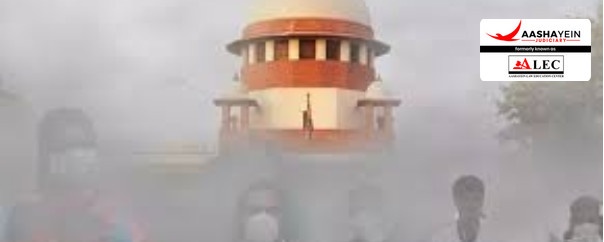The Supreme Court of India addressed the persistent issue of Delhi’s deteriorating air quality, particularly the contribution of farm fires in neighboring states. The bench, led by Justices Abhay Oka and Augustine George Masih, examined the complex sources of pollution and directed specific actions for the states of Punjab, Haryana, and Uttar Pradesh.
Not Solely Blaming One State:
The Supreme Court made it clear that farm fires in Punjab are not the only cause of Delhi's air pollution crisis during the winter months. While acknowledging the role of these fires in contributing to air pollution, Justice Abhay Oka siad, " We can't blame only one state..."
He recognized the multifaceted nature of Delhi’s pollution problem, which also involves factors like firecrackers, vehicular emissions, and industrial pollution.
You can also read the latest judgment by visiting [Latest Judgment].
For more information, visit [Aashayein Enquiry Section]
Directive for State Cooperation:
The bench ordered the Punjab, Haryana, and Uttar Pradesh governments to file affidavits after consulting one another to address the issue collaboratively. The states were tasked with finding ways to better manage agricultural waste, which is a significant contributor to the problem of stubble burning. The Court directed the Commission for Air Quality Management (CAQM) to submit its suggestions on better management, providing a clear deadline for proposing practical solutions.
Focus on Agricultural Waste Management:
The Court highlighted the suggestions by the CAQM, emphasizing the importance of crop diversification and both in-situ (on-site) and ex-situ (off-site) management of crop residue. These practices aim to reduce the burning of stubble and find more sustainable solutions for managing agricultural waste. While the Court acknowledged that Punjab had made progress, with a 70% reduction in farm fires compared to the previous year, it emphasized that more action was necessary to manage stubble more efficiently across the entire region.
Farm Fires Not the Sole Culprit:
During the proceedings, Punjab’s Attorney-General, Gurminder Singh, presented crucial data showing that Punjab had ceased reporting farm fires , which directly challenged the assumption that farm fires from Punjab were the primary cause of the ongoing pollution. This data, along with the fact that air quality continued to worsen through December and January, pointed to other significant contributors to Delhi’s pollution. Justice Oka acknowledged this, reiterating that while farm fires contributed, they were not the sole factor exacerbating Delhi’s air quality crisis.
Delhi’s Role and the Need for Enforcement:
The Court has also criticized the Delhi government’s lack of enforcement, particularly concerning the burning of firecrackers during Diwali, despite a ban in place. The Justices have voiced concerns over Delhi’s failure to implement stricter measures to control the burning of crackers, which is another major source of air pollution. The Court described the Delhi government’s explanations as "eyewash," signaling its dissatisfaction with the effectiveness of the administration’s actions.
The Supreme Court’s ruling highlights the complex, multi-source nature of Delhi’s air pollution and emphasizes cooperative federalism and accountability. It directs states to collaborate on agricultural waste management while holding them individually responsible for corrective measures. The Court also set a clear timeline for the CAQM’s suggestions, focusing on sustainable solutions and technological interventions.
Conclusion
The Supreme Court stresses that Delhi's pollution results from multiple factors and requires coordinated efforts across all levels of government. Justice Abhay Oka’s statement highlights the complexity, emphasizing collaboration over blame-shifting. The Court’s order for cooperative action sets a positive precedent for tackling environmental issues across state boundaries.

